One of the reasons why i go through the trouble of taking one bus and two trains in order to get to Z33 in Hasselt is that the Contemporary Art Center regularly identifies and confronts phenomena, ideas and flows that characterize or affect contemporary culture. Their new exhibition, Architecture of Fear, examines how feelings of fear pervade our daily life.
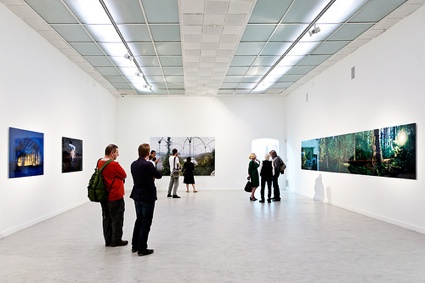 Opening Architecture of Fear. Photo: Kristof Vrancken / Z33
Opening Architecture of Fear. Photo: Kristof Vrancken / Z33
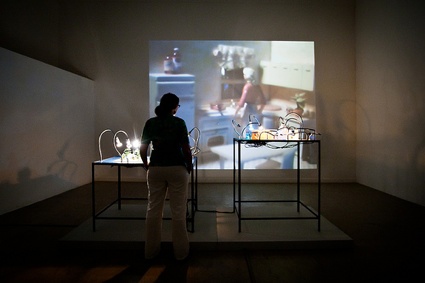 Opening Architecture of Fear. Photo: Kristof Vrancken / Z33
Opening Architecture of Fear. Photo: Kristof Vrancken / Z33
The show explores how fear has moved from being an immediate emotional strategy for survival, the result of a personal experience, to becoming a constant, more abstract, low level feeling that paves the way for new infrastructures based on security, prevention and ‘risk-managemen’t. Without ever judging nor pointing the finger, Architecture of Fear asks visitors to put their anxieties into a broader perspective. Are threats of terrorism, viral diseases, pollution and financial crisis entirely unbiased and valid? Have some of them been surreptitiously fashioned by politicians and the media? Are CCTVs in the metro making me feel more secure or in danger, for example?
As Frank Furedi, author of Politics of Fear: Beyond Left and Right, explained in an article for Spiked, “The prominent role of fear today merely indicates that it serves as a framework through which we interpret a variety of experiences.”
Architecture of Fear has invited international artists and designers to investigate how fear as a mental construction can be built up through language and images. I’ve already mentioned the work of Charlotte Lybeer and Jill Magid. I’ll come back with an interview with Trevor Paglen soon-ish. In the meantime, here’s a quick walk through some of the works in the exhibition.
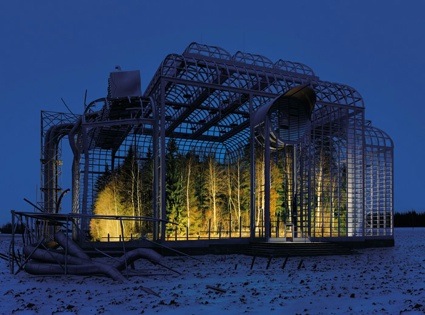 Ilkka Halso, Museum I (The Museum of Nature), 2004
Ilkka Halso, Museum I (The Museum of Nature), 2004
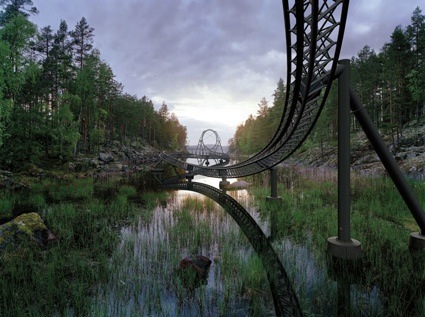 Ilkka Halso, Roller coaster (The Museum of Nature), 2004
Ilkka Halso, Roller coaster (The Museum of Nature), 2004
In Museum of Nature, photographer Ilkka Halso articulates his fear of a world where nature will be confined to museums, private amusements parks and performance spaces. The buildings will not only allow the inhabitants of the Earth to see what forests, lakes and rivers look like, they will also protects these last fragments of flora from threats of pollution and from actions of man himself.
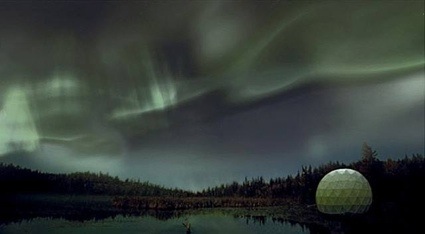 Laurent Grasso, 1619, 2007
Laurent Grasso, 1619, 2007
The works shown by Laurent Grasso in the exhibition are equally compelling and sinister but they are also more complex and allude to conspiracy theories and ambiguous military researches. The title of Grasso’s video 1619 refers to the year when Galileo Galilei first used the term “aurora borealis” in his writings.
Nikola Tesla looked into the aurora borealis almost three centuries after the Italian scientist but he was more interested in its capacity to reflect electromagnetic waves. Inspired by Tesla’s research, the American military set up the “High Frequency Active Auroral Research Program” or HAARP, a research program specialized in the application of high frequencies to the “aurora borealis” in Alaska. HAARP is studying the transmission of electricity in the uppermost portion of the atmosphere. But because of its military funding and the fears associated with electromagnetism, HAARP is surrounded by controversy. Its forest of antennas have been accused of beaming electromagnetic waves that are extremely hazardous to human health, of disrupting climate, of having all sorts of influence on human behaviour and of being weapons able to disrupt communications over large portions of the planet.
Grasso’s video artificially reproduces the color vibrations of this luminous phenomena in an environment where one can discern a geodesic sphere.
Visitors of the exhibition will find a model of that very sphere in the adjacent room. Bathed in pink light, the sculpture leads to more worrying stories, conspiracy theories and mystery.
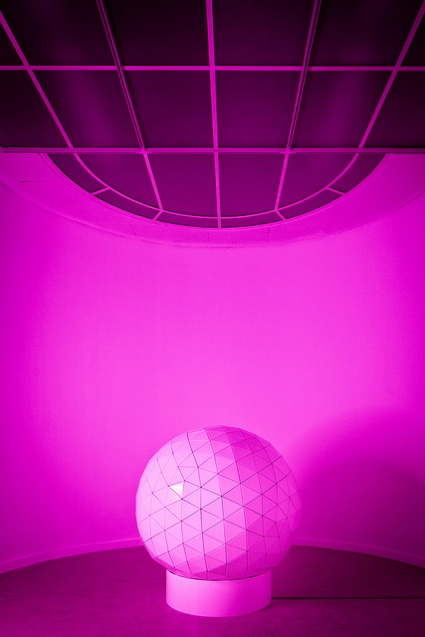 Laurent Grasso, 525, 2007, Photo: Kristof Vrancken / Z33
Laurent Grasso, 525, 2007, Photo: Kristof Vrancken / Z33
The geodesic sphere, directly inspired by Buckminster Fuller’s model, refers to the shape of the receiving stations of the Echelon network, an ambitious listening programme created in in 1947 and operated on behalf of Australia, Canada, New Zealand, UK, and the US. ECHELON was reportedly created to monitor communications between the Soviet Union and the Eastern Bloc. Since the end of the Cold War, it is believed to search for terrorist plots, drug dealers’ plans, and political and diplomatic intelligence. Some even claim that ECHELON is also used for large-scale commercial theft, international economic espionage and invasion of privacy.
Rather than researching, explaining or interpreting what lies exactly behind military uses of natural phenomena and global surveillance systems, the works by Laurent Grasso open up even more speculations, conjectures and ambiguities.
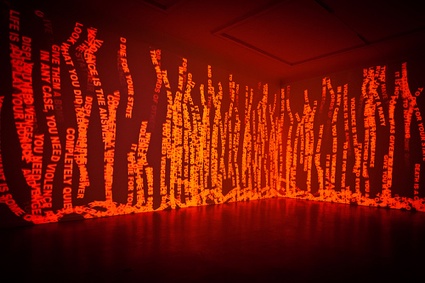 Kin-Wah Tsang, The Second Seal – Every Being That Opposes Progress Should Be Food For You, 2009. Photo: Kristof Vrancken / Z33
Kin-Wah Tsang, The Second Seal – Every Being That Opposes Progress Should Be Food For You, 2009. Photo: Kristof Vrancken / Z33
Tsang Kin-Wah‘s The Second Seal refers to the Seven Seals of the Apocalypse. In the video installation, words that seem to be made of fire descend slowly from the ceiling and snake down the walls of the gallery space. Written by the artist, the text talks of war, violence, evil, vengeance, power, death. The words attempt to articulate the complexities of our society with its many doom scenarios, its dilemmas and anxieties.
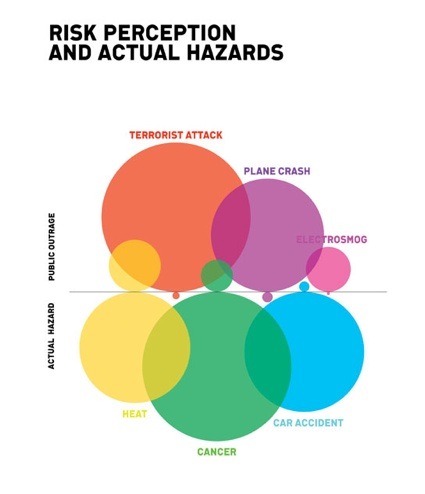 Susanna Hertrich, RISK, 2010
Susanna Hertrich, RISK, 2010
Designer Susanna Hertrich‘s Risk charts bring us back with our feet firmly on the ground. The posters confront a series of risks (terrorist attacks, plane crash, car accident, cancer, etc) as they are perceived by the public with the actual hazard they represent.
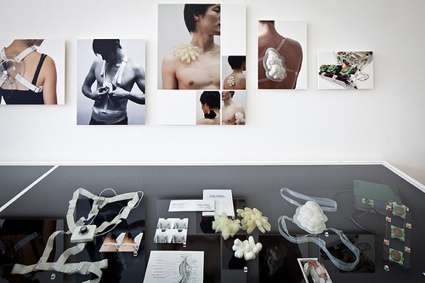 Susanna Hertrich, Prostheses for Instincts, 2008. Photo: Kristof Vrancken / Z33
Susanna Hertrich, Prostheses for Instincts, 2008. Photo: Kristof Vrancken / Z33
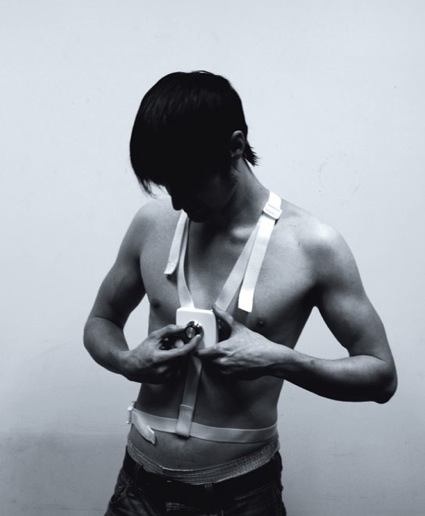 Susanna Hertrich, Alertness Enhancing Device, 2008
Susanna Hertrich, Alertness Enhancing Device, 2008
The charts are accompanied by the Alertness Enhancing Device and other Prostheses for Instincts that aim to awaken human beings’ long lost natural instinct for the real dangers of life, as opposed to the above-mentioned perceived risks that often cause a public outrage.
Through electronic simulation, some prostheses are able to create physical and mental sensations (goose bumps, shivers down the spine, hair standing up on your neck) similar to the ones we experience in instinctive fear responses.
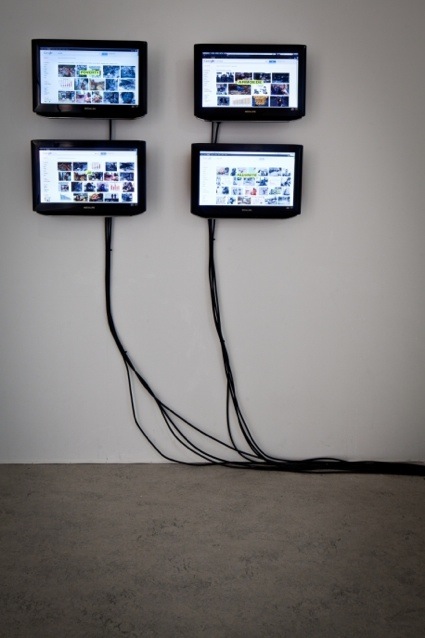 De Geuzen, Global Anxiety Monitor, 2007. Photo: Kristof Vrancken / Z33
De Geuzen, Global Anxiety Monitor, 2007. Photo: Kristof Vrancken / Z33
Global Anxiety Monitor, by De Geuzen, investigates reasons for paranoia as well but brings them into a different perspective. The work looks for anxiety buzzwords on Google image and shows side by side the results obtained in several languages. Sometimes the google image angle on pollution, torture, recession, future or unemployment coincide in all the languages investigated, sometimes they are at odds with each other and reveal cultural biases and local tensions.
More details about Architecture of Fear in the mini catalogue available online for free:
Architecture of Fear remains open at Z33 in Hasselt, Belgium through December 31, 2011. Entrance is free.
Previously: ‘The Villages’, empty capsules for dream, Dutch lifestyle and Discussing democracy, torture and secret services with Jill Magid.
